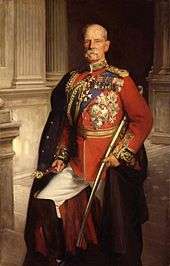Uniforms of the British Army
The uniforms of the British Army currently exists in sixteen categories ranging from ceremonial uniforms to combat dress.
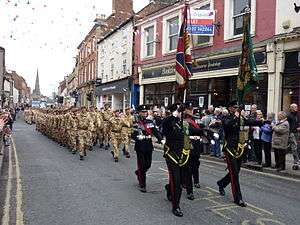
History

- See also: Red coat (British army)
Prior to the English Civil War of 1642–51 the only significant instances of uniform dress in British military culture occurred in small bodyguard units, notably the Yeoman of the Guard. During the Civil War the Parliamentary New Model Army adopted a fairly standardised pattern of red clothing, a practice which continued with the small regular English Army of the Restoration period.[1]
By the end of the 17th century, the English army uniform's colour (England not yet having joined with Scotland to form the United Kingdom), was largely settled on red with few exceptions. The practice of distinguishing regiments by different facings was in general use by the early 18th century. In the decades after the end of the Napoleonic Wars, British Army uniforms trended towards extravagance rather than practicality. That trend was reversed during Crimean war with the adoption of looser fitting tunics and more practical headdresses. Red coats were however retained, except in India where drab coloured garments were introduced in 1848 [2] and worn increasingly from 1857 on.[3]
In January 1902 the British army adopted a universal khaki uniform for home service wear, the Service Dress, after experience with lighter khaki drill in India and South Africa. The traditional scarlet, blue and green uniforms were however retained for full dress and off duty "walking out dress" wear. Details of these colourful uniforms varied greatly between regiments and branches of the army.[4] The early use of camouflage in the form of plain khaki reflected the exigencies of colonial war and the freedom allowed, and taken, by many of the officers who fought it. The adoption of khaki for active service resulted from the development of weapons of greater accuracy range combined with smokeless powder during the late 19th century, making low-visibility on the battlefield a matter of priority.[5]
In 1938, the British Army adopted a revolutionary and practical type of uniform for combat known as Battledress; it was widely copied and adapted by armies around the world.[6] During the Second World War a handful of British units adopted camouflage patterned clothes, for example the Airborne Forces' Denison smock and the windproof suit. In the late 1960s the Disruptive Pattern Material (DPM) camouflage uniform was adopted across the whole of the British Army. It remained in service, with periodical updates, for the next 40 years. From 2009 it began to be replaced by a new Multi-Terrain Pattern (MTP) uniform. This "Personal Clothing System (Combat Uniform)" has been developed for use across the British Armed Services, making use of the latest in clothing technology. Unlike the different versions of DPM issued for use in different terrains, the new MTP kit is issued in just one version, designed to function effectively across a variety of terrains, meeting a need identified in recent combat experience.
-

4th Regiment of Horse in 1687
-
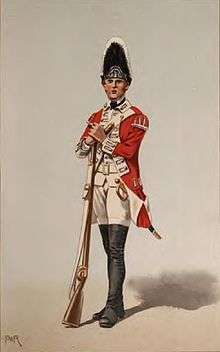
Grenadier of the 40th Regiment of Foot in 1767
-

Officer and private of the 40th Regiment of Foot in 1815
-

Soldiers of the 53rd Regiment of Foot in 1849
-
.jpg)
A Sergeant Major of the Leicesters in Service Dress, 1915
-

An officer in officer's temperate Service Dress and soldier in the other rank's tropical Service Dress in Bermuda, in 1942.
-
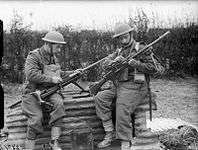
Soldiers of the Border Regiment wearing Battledress in 1940
-

A Warrant Officer and Non-commissioned officers of the Bermuda Militia Artillery wear Battledress at St. David's Battery, , Bermuda, c. 1944
-
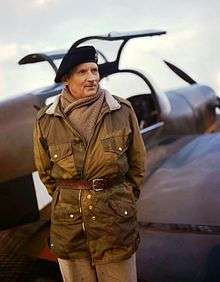
Field Marshal Bernard Montgomery wearing a Denison smock of the type issued to airborne soldiers for wear over the Battle Dress uniform. This smock evolved through several versions before being replaced by the Smock Parachutist DPM in the 1970s.
-

The British Army in Burma 1945. The tropical uniform consisted of green cotton shirt and trousers (the latter cut to the same pattern as the temperate serge Battle Dress trousers), ankle boots worn with puttees or anklets, bush hats (helmets are worn here, but were of little use in jungle conditions), and 1937 Pattern carrying equipment (green 1944 Pattern carrying equipment would become the norm in jungle terrain until the introduction of the 1958 Pattern). This uniform would be worn through the Malaysian Emergency
-

British soldiers in khaki drill uniforms, including shorts, in the Western Desert in 1942.
-

Parachute Regiment soldiers in Aden in 1956 wearing khaki drills and berets, with carrying equipment stripped to ammunition pouches.
-
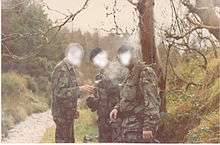
Ulster Defence Regiment soldiers in South Armagh wearing 1968 Pattern DPM combat jackets and trousers, with green shirts and berets. This was the basic temperate combat uniform during the 1970s and early 1980s, worn with green sweaters, ankle boots and puttees, and 1958 Pattern webbing.
-

Royal Bermuda Regiment recruits in 1993 wearing green lightweight trousers, green shirts and sweaters, with 1968 Pattern DPM combat jackets, berets, and DMS high-boots and equipped with 1958 Pattern carrying equipment
Uniform numbers
Fourteen numbered 'orders' of dress (in addition to full dress) are set out in Army Dress Regulations[7] though individual Regiment and Corps dress committees do add to this. "Full Dress" is also prescribed for individual regiments; outside the Household Division it is however seldom worn except by regimental drummers, buglers and other limited categories.
Note that uniform distinctions can vary greatly from one Regiment or Corps to another, and the following descriptions are a generalization. Also, while there are officially fifteen different grades (or 'Numbers'), many of these are rarely worn or are being phased out altogether. (For example, the different varieties of combat uniform (No. 5 (Desert), No. 8 (Temperate) and No. 9 (Tropical)) though still listed in the dress regulations, are in the process of being replaced by the new Personal Combat System – Combat Uniform or PCS for short. It uses the Multi-Terrain Pattern camouflage and is sometimes mistakenly called MTP uniform.
| Different orders of dress as worn by the former Chief of the Defence Staff (Nick Houghton) | ||||||||||
|---|---|---|---|---|---|---|---|---|---|---|
|
Full dress
- See also: Full dress
Full dress is the most elaborate and traditional order worn by the British Army. It was withdrawn from general issue in 1914. The Household Division resumed wearing their scarlet and blue full dress in 1920, but for the remainder of the Army, red coats and other colourful items of dress were only worn by regimental bands; in mess dress or on certain limited social or ceremonial occasions. An example of the latter was the 1937 Coronation when mounted detachments from participating cavalry regiments were issued with full dress uniforms for the occasion.[8] The reason for not generally reintroducing the distinctive full dress between the wars was primarily financial, as the scarlet cloth required expensive red cochineal dye.[9]
Full dress is now rarely worn except by the Foot Guards and the Household Cavalry. It is issued at public expense to these units and to Corps of Army Music Bands for ceremonial use.[10] Other units may obtain Full Dress on occasion as it can be worn whenever a parade is attended or ordained by the monarch or a member of the British Royal Family, including ceremonial parades, state funerals, and public duties around royal residences (such as the Changing of the Guard). It is worn by all members of the Household Division attending the Lord Mayor's procession, and also when participating in guards of honour or recruiting drives.[11] Most regiments maintain full dress for limited special categories. These include bandsmen, drummers (line infantry), buglers (rifles), trumpeters (cavalry) and pipers (Scottish and Irish units). However, all of these uniforms must be purchased and maintained from non-public funds.[12]
Each regiment or corps retaining Full Dress has its own pattern, approved by the Army Dress Committee.[13] They are generally a modified version of the pre-1914 uniforms. In the case of units created since the First World War, such as the Army Air Corps, the Full Dress order incorporates both traditional and modern elements. Not all Full Dress uniforms were (or are) scarlet; Rifle regiments wore dark 'Rifle' green, and the majority of light cavalry regiments wore dark blue (as did the Royal Artillery and the various support corps). Line Infantry regiments though invariably wore scarlet, as did heavy cavalry with the exception of the Royal Horse Guards and the 6th Dragoon Guards (The Carabiniers).[14]
| Examples of Full dress uniform | ||||||||||||||
|---|---|---|---|---|---|---|---|---|---|---|---|---|---|---|
|
No.1: Temperate ceremonial uniform
No. 1 Dress, sometimes referred to as "blues", is a universal ceremonial uniform which is almost consistent throughout the British Army. No. 1 Dress is only worn on ceremonial occasions, and, in some regiments, by the duty officer. It is also regularly required to be worn by a short list of other units, senior staff officers, and officers appointed as aides to the Royal Family[15] and to the personal staff of senior officers in command. The order is not generally issued to all units, with the khaki No. 2 Dress functioning as the main parade uniform.
The origins of No 1 Dress can be traced back to various "undress", "patrol" or "frock" uniforms worn for semi-formal or ordinary duty occasions in the late 19th century. In its present form it dates from an order of dress issued at the time of the 1937 Coronation, intended as a cheaper alternative to the full dress uniforms that had been generally withdrawn after 1914. In 1947 a trial issue of what was now termed No 1 Dress was made with regimental distinctions as detailed below. Army units participating in the 1953 Coronation wore the new uniform as a temporary issue.
For most regiments and corps No. 1 dress consists of a dark blue tunic and trousers or overalls (or skirt) with a coloured peaked cap. Females should wear normal dark coloured tights when needed. Different units are distinguished by the colouring of the cap, piping on the tunic and of the welts or stripes on the trousers, as well as badges and in certain Cavalry Regiments by the colour of the collar.
There are some exceptions. The tunic and trousers of The Essex Yeomanry, The Rifles and Royal Gurkha Rifles are rifle green, while the Royal Dragoon Guards and the King's Royal Hussars wear dark green and crimson overalls (tight fitting cavalry trousers) respectively. Cavalry regiments wear shoulder chains in place of shoulder straps.
The Royal Regiment of Scotland wears a short jacket called a "doublet" in Archer Green. Prior to amalgamation Highland regiments wore it with the kilt and sporran while Lowland regiments wore trews. The kilt or trews were in the individual regiment's tartan pattern. This is now worn with the Glengarry folding cap, which has a badge backing of Black Cock's feathers and a colored battalion hackle. Musicians wear a scarlet doublet and the Feathered Bonnet (a wire frame covered in ostrich plumes,[16] not a bearskin headdress as some have mistaken it).
In the full ceremonial order of No. 1 Dress, officers wear a waist sash of crimson silk while general officers wear a waist sash of gold and crimson stripes. Light cavalry regiments wear a lace crossbelt in place of the sash while Rifle regiments wear a polished black leather crossbelt. Other ranks wear a white buff or black leather belt with a regimental pattern locket, with a bayonet frog if carrying arms.
The peaked cap is not worn by all regiments; berets are worn in lieu by the Royal Tank Regiment, Army Air Corps, Parachute Regiment, Special Air Service and Intelligence Corps.[17] Berets are also worn by officers and other ranks of the Royal Regiment of Fusiliers and other ranks of the Royal Welsh in which feather hackles are displayed, recalling the plumes formerly worn on the full dress busby.[17] The Royal Regiment of Scotland wear a regimental glengarry with cockfeathers taken from the former ceremonial uniform of the Royal Scots and the King's Own Scottish Borderers, the Royal Irish Regiment wear the caubeen, while the Brigade of Gurkhas wear a round Kilmarnock cap.[17]
Related to No. 1 Dress is the 'Frock Coat' sometimes worn by senior officers (of Lieutenant-General rank and above, or holders of certain Royal appointments), officers of the Household Division and some bandmasters etc. although all three are of different design. Dating from the 19th century, this item of uniform is usually worn with the peaked cap, but on occasion it is worn with the British Army cocked hat by certain office-holders.[18]
-
Various patterns of No.1 dress being worn at the presentation of new colours to the Royal Military Academy Sandhurst
-
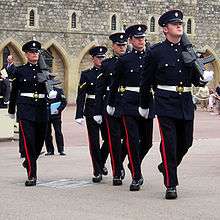
Soldiers of the Worcestershire and Sherwood Foresters Regiment in No.1 dress
-

A private of the Royal Regiment of Scotland wearing the Scottish version of No.1 dress.
-
Major-General Sir Evelyn John Webb-Carter in the No.1 dress uniform of the Colonel of the Duke of Wellington's Regiment[1]
-

Major-General Sir Peter Wall wearing a Frock coat
-

Frock coat worn with cocked hat by the Queen's representative in Jersey.
-
.jpg)
Riflemen in dark green No.1 dress uniform; bugler (foreground) in full dress busby (also called 'shako')
- ^ He is wearing Colonel's (not Maj Gen's) Rank as he is in his uniform as the Colonel of The Regiment
No.2: Service dress (temperate parade uniform)
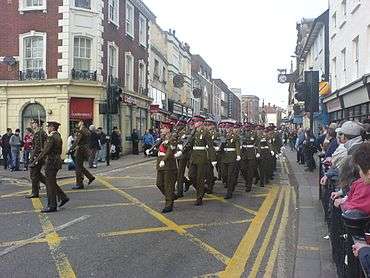
Originally issued as a field uniform (see Service Dress (British Army)), this uniform is worn for most formal duties by all units. No.2 dress consists, for most corps and regiments, of a khaki jacket, shirt and tie with trousers or a skirt. In the ceremonial form of No. 2 Dress, the head dress is the same as that worn with No.1 dress, with the exception of the Brigade of Gurkhas, who wear the slouch hat and officers of The Queen's Royal Hussars who wear their "tent hat" (the only head dress worn without a cap badge or other distinction). The Royal Regiment of Scotland wear a special pattern of jacket with a cut away front, worn with a regimental tartan kilt or trews. Coloured trousers are worn by some units: crimson by the King's Royal Hussars and dark green by the Royal Irish Regiment and Royal Dragoon Guards.
All officers and Other Ranks now wear the same style and colour of Service Dress and it is issued for free to all. Officers are required to purchase the caps, belts and shoes for which they are given a cash grant. The only variations of the standard jacket are the jackets worn by the Foot Guards whose buttons are grouped differently depending on their regiment; and the Royal Regiment of Scotland who wear a "cut away" form of the jacket to be worn with kilts.
Regimental distinctions worn on No.2 dress can include collar badges (sometimes with coloured cloth backings), coloured lanyards worn on the shoulder, and arm badges. Regimental buttons are worn; for most units these are of gold or silver colour, with black buttons worn by The Rifles, Gurkhas and Royal Army Chaplains Department and Bronze by the Princess of Wales's Royal Regiment. Officers and Warrant Officers Class One of some (but not all) Regiments and Corps wear a leather Sam Browne belt (that of 1st The Queen's Dragoon Guards is of pig skin which is not to be highly polished) or a cross belt. Infantry Warrant Officers Class Two and SNCOs wear a scarlet (for WOs) or crimson (for SNCOs) sash over the right shoulder to the hip. Soldiers wear a white or black plastic waist belt with a plate buckle displaying the regimental badge in ceremonial uniform – a plain khaki belt in non-ceremonial.
Every regular army soldier is issued with one suit of No.2 dress. In general, issue of this order of dress to units of the Army Reserves is to all officers and SNCOs with pools of khaki uniforms being held by units for use by Cpls and below.[19]
No.3: Warm weather ceremonial uniform
No.3 dress is the warm weather equivalent of No. 1 dress, worn for specified overseas stations or assignments. When adopted in the early 1950s, it comprised an all-white cotton drill high-collared tunic, cut in a similar fashion to the No. 1 dress jacket, plus white trousers. These were worn with the coloured No.1 dress cap. No. 3 dress was typically issued temporarily, being withdrawn from units on leaving the station. This order of dress dates back to white drill uniforms worn for "hot-weather" ceremonial and off-duty wear in India prior to World War I.[20]
Since the 1970s this order has consisted of the same white tunic but is now worn with coloured No. 1 dress trousers.[21] Head-dress, footwear and badges are generally as for No. 1 dress. Widely worn during the 1950s and 1960s (when Britain still maintained significant garrisons in tropical stations) this uniform is now usually restricted to military attaches in tropical postings and their personal staffs,[22] the Bermuda Regiment (see below) and a few bands, The band of the Royal Gibraltar Regiment is entitled to a permanent issue of No. 3 dress.
No.4: Warm weather Service Dress (officers only)

Issued to officers on first posting to a warm weather area: the uniform is similar to No.2 dress but in a stone coloured polyester / woolen worsted mix. No.4 dress may be worn on formal occasions when not on parade with troops.
When officers are taking part in parades and formations with other ranks in warm weather areas, they wear either No.3 or No.6 dress.
There had been an Other Ranks pattern of warm weather Service Dress, but this fell out of use after the 1950s.
No.5: Battledress [Obsolete] (1939–1961)
Battledress (BD) refers to the combat utility uniform issued from 1939 to the early 1960s, often incorrectly called the Pattern (19)37 uniform, that replaced the No.2 Service Dress. It consisted of a short jacket called a blouse and high-waisted trousers made of khaki wool serge worn with a beret or side-cap. It was also issued in Postman Blue for the Royal Air Force, Navy Blue for the Royal Navy / Royal Navy Volunteer Reserve, and Dark Blue for the Civil Defence Corps. Officers were permitted to have the collar of the BD jacket tailored to have faced lapels, allowing the wearing of a shirt and tie underneath, inspiring the later American M44 'Ike Jacket'. Originally introduced in 1939, design modifications were made in 1940 (Austerity Pattern), 1942 (Pattern (19)40), and 1949 (Pattern (19)49). It became a smart barracks and walking-around dress with the introduction of the Jungle Green combat dress uniforms in the mid-1940s and is synonymous with the British soldier of the 1940s and 50s.
The Battledress had some drawbacks. The uniform was designed for the temperate clime of the United Kingdom or Northern Europe. It was found too heavy for wear in summertime, the sunnier climate of Southern Europe (like the Mediterranean Theatre) or in tropical or jungle climates (like the Pacific Theatre) and too lightweight for cold weather or high altitudes (like Korea). It was also very difficult to iron due to the complex series of pleats. It became obsolete in 1961 and No.2 Service Dress was reintroduced in its place in 1962 for barracks and parade use.
No.5: Desert combat dress
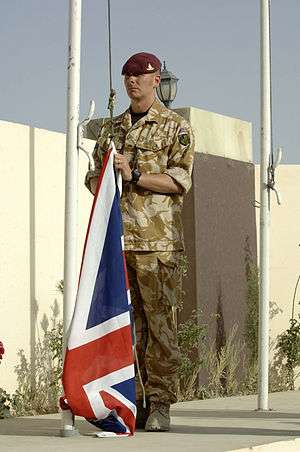
Desert combat clothing is listed as: hat, jacket and trousers DPM and is issued to soldiers posted to Cyprus and the Middle East. As issued during the 1991 Gulf War, this uniform was identical to the No. 9 DPM tropical uniform, except for the multi-tone desert camouflage. This was quickly replaced with a two-tone desert version of DPM camouflage (the base colour and one other). Smocks were also available in the desert DPM, including the SAS pattern windproof smock. Covers for combat helmets and body armour were also made in this camouflage prior to their replacement by Multi-Terrain Pattern (MTP) camouflage.
Since 2011, No 5 Dress has no longer been issued due to the introduction of the Personal Clothing System – Combat Uniform (PCS-CU).
No.6: Warm weather parade uniform (bush jacket)
The "bush jacket" uniform (in Australia, this is known as the "safari uniform"). It is issued to all officers and ORs on posting to a warm weather station. It consists of a tan bush-style 4-button jacket worn with or without a shirt and tie underneath and tan trousers. It is worn by all ranks for parades (as with No. 2 Dress), unless No. 3 dress is worn, and by ORs for all other occasions.
No.7: Warm weather barrack dress
The tropical shirt-and-trousers uniform, consisting of a stone coloured short-sleeve shirt worn with stone coloured trousers (kilt or trews for Scottish regiments), stable belt and regimental headgear.
No.8: Temperate Combat Dress

The current No.8 Dress, which was introduced as part of Project PECOC in 2011 and also replaced Nos 5 and 9 Dress, is known as Personal Clothing System – Combat Uniform (PCS-CU) it is based around a Multi-Terrain Pattern (MTP) windproof smock, a lightweight jacket and trousers with a range of ancillaries such as thermals and waterproofs. In recent years, the British army has introduced Tactical Recognition Flashes (TRFs) – worn on the right arm of a combat uniform, this distinctive insignia denotes the wearer's regiment or corps (or sub division thereof in the case of the AGC). PCS-CU is designed to be lightweight, yet durable enough to be used throughout rigorous activities soldiers find themselves performing; and with the idea that layers of clothing are warmer and more flexible than a single thick layer.
Working headress is normally worn, which is typically a beret. The colour of the beret usually shows what type of regiment the wearer is from. The colours are as follows:
- Khaki—Mercian Regiment, Foot Guards, Honourable Artillery Company, Princess of Wales's Royal Regiment, Royal Anglian Regiment, Duke of Lancaster's Regiment, Royal Welsh, Yorkshire Regiment, Royal Gibraltar Regiment, 4/73 (Sphinx) Special Observation Post Battery RA[23]
- Light grey—Royal Scots Dragoon Guards
- Dark grey—Queen Alexandra's Royal Army Nursing Corps
- Brown—King's Royal Hussars, Royal Wessex Yeomanry
- Black—Royal Tank Regiment, Westminster Dragoons Squadron, Royal Yeomanry, Royal Artillery, Royal Logistics Corps
- Dark (Rifle) green—The Queen's Royal Hussars (with broad brow band), The Rifles, Royal Gurkha Rifles, Small Arms School Corps, Essex Yeomanry
- Maroon—Parachute Regiment, all ranks serving with 16 Air Assault Brigade (not restricted to Parachute qualified personnel) other than the non Parachute Regiment Infantry Battalion or Army Air Corps and attached Arms personnel
- Beige—Special Air Service including attached troops who are not SAS-qualified
- Emerald grey[24]—Special Reconnaissance Regiment
- Commando green—Commando qualified personnel serving in Commando units (including the Special Boat Service)
- Cypress green—Intelligence Corps
- Cambridge blue—Army Air Corps including attached personnel and REME Aircraft trades
- Scarlet—Royal Military Police
- Green—Adjutant General's Corps (except Royal Military Police, who wear scarlet; Military Provost Staff, Education and Training Services Branch and Army Legal Service, who wear navy blue), Military Provost Guard Service
- Navy blue—all other Army units (except Scottish line infantry regiments and the Royal Irish Regiment)
A regiment or corps cap badge is worn on the beret or other head dress worn in No. 8 Dress. The badge is positioned above the left eye when a beret or a caubeen is worn; the badge worn on the Tam O'Shanter sits above the left ear. Uniquely D (London Irish Rifles) Company of The London Regiment wear their cap badge over the right eye, on their cabeen.
Troops from other services, regiments or corps on attachment to units with distinctive coloured berets often wear the latter with their own cap badge. Colonels, brigadiers and generals usually continue to wear the beret of the regiment or corps to which they used to belong with the cap badge distinctive to their rank. The Royal Regiment of Fusiliers wears a feather hackle on the beret, they are now the only infantry regiment to wear the navy blue beret. Other ranks of the Royal Welsh also wear hackles.

The Royal Regiment of Scotland and Royal Irish Regiment, instead of the beret, wear the Tam O'Shanter and the caubeen respectively, both of which feature hackles. The Tam O'Shanter is also worn by some UOTCs and Army Reserve units in Scotland.
Prior to the adoption of PCS-CU, the beret was often substituted by the Mk 6 Combat Helmet with a DPM cover (or desert DPM if worn with No.5 Dress); this has since been replaced by the Mk 7 helmet with a MTP cover and some scrim netting for the insertion of additional camouflage. In jungle conditions, the helmet is usually substituted by a MTP bush hat – or equally in cold conditions, a MTP peaked hat (Cap, Extreme Cold Weather), a rolled woollen tube known as a cap comforter, or other specialised headgear. When the British Army finds itself in peacekeeping roles, regimental headress is worn (where the tactical situation allows) in preference to the helmet or MTP hat, in order to appear less hostile to local civilians. When working for the United Nations, soldiers will wear the pale blue UN beret.
The PCS-CU jacket may be either tucked into the trousers or worn loose, with sleeves rolled either up or down ; the decision as to which of these variations is to be worn within units rests with the Commanding Officer.
Some Regiments and Corps wear a stable belt in No 8 dress whilst others restrict its use to Nos 13 and 14 Dress. The stable belt is a wide belt, made of a tough woven fabric. It is traditionally fastened with a set of leather straps and buckles on the wearer's left hand side (in some units to their front), but may alternatively have a metal locket arrangement, or a plate at the front bearing regimental, or formation insignia. The fabric of the belt itself is in regimental colours, either a single colour or striped along its length. The origin of these combinations is often traditional, derived from historic uniform colours and facings, and may coincide with the design of a particular unit's TRF.
On exercises and operations the stable belt is replaced with a plain green field belt, with nylon Personal Load Carrying Equipment and the Osprey body armour vest with pouches attached using the PALS system being worn for load-bearing purposes.
No.9: Tropical Combat Dress
No.9 dress is no longer provided, being replaced by PCS-CU. It was made from cotton or poly-cotton DPM material of a lighter weight than pre-Combat Soldier 95 No 8 Dress The jacket was similar in cut to a shirt and had epaulettes fitted to the shoulders. Its sleeves could be rolled above the elbow and the shirt tucked into the trousers for a smarter appearance for example in barracks. There is a large pocket on each breast, closed with a button-down flap, and a first field dressing pocket on one sleeve. This uniform was normally worn with a DPM bush hat; out of the field, regimental headdress was often worn. The trousers had button down belt loops, when carrying equipment was not worn, a uniform belt was worn in these loops.
No.10: Temperate mess dress
The British Army's temperate mess dress includes a waist-length short jacket, with which men wear trousers, overalls or a kilt; and for women a long skirt. No. 10 dress is normally worn by sergeants and above for formal evening functions. Colours vary greatly from unit to unit but generally match those of the traditional full dress of the regiment or corps. Thus mess jackets can be scarlet, dark blue or green with facings and waistcoats in regimental colours. Two basic patterns of jacket are worn: the high collared "cavalry" style and the open-fronted one with lapels formerly worn by officers of infantry regiments. The version of No. 10 dress worn by officers frequently includes elaborate braiding on the waistcoats.
No.11: Warm weather mess dress
A white jacket is substituted for the coloured one of temperate mess dress. Waistcoats are not worn.
No.12: Protective clothing
This order of dress includes various types of protective clothing ranging from standard overalls to specialist kit worn by aircrews, chefs, medics and others.
No. 12 also covers whatever day-to-day working dress may be authorised at a local or regimental level. Formerly an olive green shirt and trousers were often worn, but this has been replaced with smart Combat Dress: ironed shirt and trousers worn with beret and stable belt (identical to that of No. 7 Dress).
No.13: Temperate barrack dress
Khaki Barrack dress trousers (as issued under the Future Army Dress (FAD) programme) and the standard issued shirt from No.2 dress with pullover. The stable belt is worn over the pullover by some Regiments and Corps. Some regiments' officers and WOs may wear coloured pullovers in place of the green pattern; the following regimental patterns and colours are authorised:[25]
- Grey/blue v-neck: Royal Scots Dragoon Guards
- Grey/blue/green knit: Queen's Royal Lancers
- Grey/brown v-neck: 1st The Queen's Dragoon Guards
- Grey/green v-neck: Royal Regiment of Fusiliers
- Grey v-neck: Queen Alexandra's Royal Army Nursing Corps
- Green v-neck: Princess of Wales's Royal Regiment, 307 (South Nottinghamshire Hussars Yeomanry) Battery RA (V)
- Lincoln green v-neck: 68 (Inns of Court and City Yeomanry) Signal Squadron (V)
- Brunswick Green knitted crew neck: Royal Dragoon Guards
- Dark green: Queen's Royal Hussars
- Emerald green v-neck: Royal Army Dental Corps
- Brunswick green v-neck: 9th/12th Royal Lancers
- Lovat green v-neck: Royal Yeomanry
- Green fleck v-neck: Royal Wessex Yeomanry
- Lovat green and red fleck v-neck: Essex Yeomanry
- Black: Royal Tank Regiment, Royal Army Chaplains Department, Army Legal Services Branch[26]
- Navy/corvette blue: Royal Artillery
- Dark blue: 94 (Berkshire Yeomanry) Signal Squadron (V)
- Dark blue v-neck: A (London Scottish) Company, The London Regiment
- Storm blue v-neck: Queen's Own Yeomanry
- Light blue/green fleck: Light Dragoons
- Maroon: Royal Army Veterinary Corps
- Dull cherry v-neck: Royal Army Medical Corps
- Brown/crimson with brown shoulder and elbow pads: King's Royal Hussars
- Buff: Mercian Regiment
- Mid brown v-neck: Royal Mercian and Lancastrian Yeomanry
A regimental pattern coloured side hat (officially described as a field service cap) may be worn at the commanding officer's discretion. Warrant officers customarily carry pace sticks when in this order of dress.
No.14: Shirt Sleeve Order
As for No.13, but with the shirt sleeves rolled up to above elbow level or the issued short sleeve barrack dress shirt. The pullover is not worn.
See also

- Battledress
- Battle Dress
- Denison Smock
- Stable belt
- Canadian Para Smock
- Smock Windproof DPM
- DPM Parachute Smock
- Red coat (British army)
- Military uniform
- Mess dress
- Modern equipment of the British Army
- Multi-Terrain Pattern (New replacement camouflage from 2010 onwards)
- British Armed Forces uniforms
External links
References
- ↑ Barnes, R.M.. (1972). A History of the Regiments & Uniforms of the British Army. First Sphere Books. pp. 220–221.
- ↑ "Khaki Uniform 1848–49: First Introduction by Lumsden and Hodson", Journal of the Society for Army Historical Research, JSAHR 82 (Winter 2004) pp 341–347
- ↑ Carman, W.Y. (1968). British Military Uniforms from Contemporary Pictures. Hamlyn Publishing Group. pp. 153 & 154.
- ↑ Haswell, A.E. (2009). Vanished Armies. Shire. pp. 9 to 18. ISBN 978-0-7478-0739-1.
- ↑ Mollo, John. Military Fashion. p. 210. ISBN 0-214-65349-8.
- ↑ Kannik, Preben (1968), Military Uniforms of the World in Colour, Blandford Press Ltd, ISBN 0-71370482-9 (p. 245)
- ↑ British Army Dress Committee (August 2005). Joint Service Publication 336: The Defence Supply Chain Manual. Vol. 12, Part 3, Pamphlet 3, Sect. 1 (3rd ed.). Retrieved 29 July 2008.
- ↑ Barthorp, Michael. British Cavalry Uniforms since 1660. p. 158. ISBN 0-7137-10438.
- ↑ Carman, W.Y. (1968). British Military Uniforms from Contemporary Pictures. Hamlyn Publishing Group. p. 158.
- ↑ -->British Army Dress Committee (August 2005). Joint Service Publication 336: The Defence Supply Chain Manual. Vol. 12, Part 3, Pamphlet 12, Sect. 1 (3rd ed.). p. Para. 117, 119.
- ↑ British Army Dress Committee (August 2005). Joint Service Publication 336: The Defence Supply Chain Manual. Vol. 12, Part 3, Pamphlet 12, Sect. 1 (3rd ed.). p. Para. 105. Retrieved 2008-07-29.
- ↑ British Army Dress Committee (August 2005). Joint Service Publication 336: The Defence Supply Chain Manual. Vol. 12, Part 3, Pamphlet 12, Sect. 1 (3rd ed.). p. Para. 104. Retrieved 2008-07-29.
- ↑ British Army Dress Committee (August 2005). Joint Service Publication 336: The Defence Supply Chain Manual. Vol. 12, Part 3, Pamphlet 12 (3rd ed.). Retrieved 2008-07-29.
- ↑ Major R.M. Barnes, pages 295–296 "A History of the Regiments & Uniforms of the British Army", First Sphere Books 1972
- ↑ British Army Dress Committee (August 2005). Joint Service Publication 336: The Defence Supply Chain Manual. Vol. 12, Part 3, Pamphlet 3, Sect. 3 (3rd ed.). p. Para. 313. Retrieved 2008-07-29.
- ↑ Section 604 Dress Regulations for the Army 1900
- 1 2 3 British Army Dress Committee (August 2005). Joint Service Publication 336: The Defence Supply Chain Manual. Vol. 12, Part 3, Pamphlet 15 (3rd ed.). p. Annex A. Retrieved 2008-07-29.
- ↑ http://www.army.mod.uk/documents/general/Rifles_Dress_Guidance__2012_Srl_7.pdf
- ↑ The Defence Supply Chain Manual, JSP 336 (3rd Edition), Volume 12, Pamphlet 7, Clothing regulations and scales Territorial Army (all ranks)
- ↑ R.M. Barnes, page 281 "A History of the Regiments & Uniforms of the British Army" First Sphere Books 1972
- ↑ Paragraph 16, Dress Regulations for the Mercian Regiment, January 2009
- ↑ Royal Artillery Standing Orders: part 5 – Dress
- ↑ "Yorkshire Gunners honoured for Service in Iraq and Afghanistan". Ministry of Defence.
Earlier in the day, in what marks a historic change in the history of one of the Batteries from the Regiment – 4/73 (Sphinx) Battery, the traditional dark blue beret of the Royal Artillery was replaced with a khaki-coloured beret. The change came about as a result of the Battery working closely, in times of war, with the Honourable Artillery Company
- ↑ Royal Air Force Regiment Association, Birmingham Branch Newsletter Issue No. 267, September 2011, Page 6
- ↑ Material Regulations for the Army, Volume 3, Pamphlet 16, Optional Items of Dress (Note that Mat Regs have now been replaced by Army Dress Regulations so this reference is no longer current)
- ↑ AGC PRI shop – Black ALS woollen jumper http://www.shopagc.co.uk/shopdisplayproducts.asp?id=55&cat=Clothing
_General_Sir_Nicholas_Houghton_KCB_CBE_MOD_45153633.jpg)


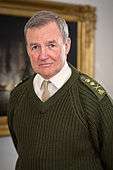




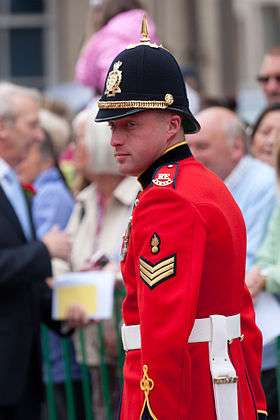
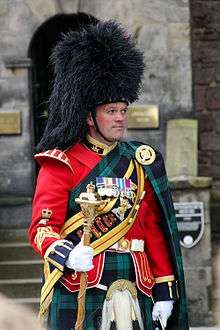
_2005-11-12-2.jpg)
